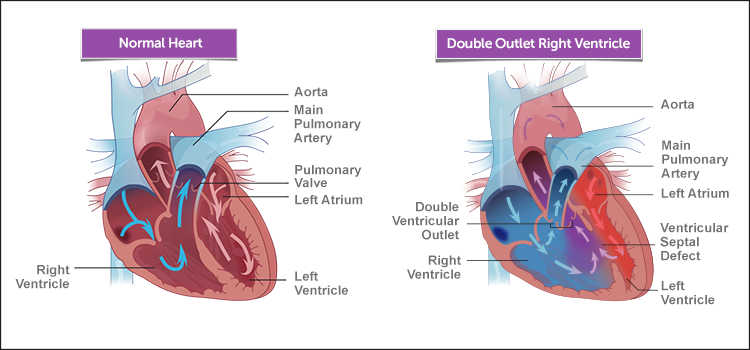DORV | Diagnosis & Treatments
How is double outlet right ventricle diagnosed?
If your newborn baby has a bluish tint to the skin or your young child has symptoms of a heart condition, your pediatrician will refer you to a pediatric cardiologist (heart doctor) for a full examination.
The cardiologist will listen to your baby’s heart and lungs to assess for a heart murmur — a noise heard through a stethoscope that is caused by the turbulence of blood flow. He or she will also measure the oxygen level in your baby’s blood. This examination will give the doctor an idea of the kind of heart problem your baby may have.
In some cases, signs of a congenital heart defect may be found by a routine prenatal ultrasound during pregnancy. If this is the case, a cardiac ultrasound of the baby in utero is usually the next step.
The doctor may also order one or more of the following tests to diagnose DORV and any related heart conditions:
- electrocardiogram(ECG or EKG)
- echocardiogram (cardiac ultrasound)
- chest x-ray
- cardiac catheterization
What are the treatment options for double outlet right ventricle?
Children with double outlet right ventricle (DORV) will need surgery to close the hole in the heart and connect the aorta to the left ventricle and the pulmonary artery to the right ventricle.
The most common surgical procedure for DORV with a ventricular septal defect (VSD) is called intraventricular tunnel repair. For this surgery, the surgeon creates a kind of tunnel to connect the left ventricle to the aorta. A patch placed within the heart directs left ventricle blood flow to the aorta.
Another procedure, called an arterial switch operation, is necessary if the aorta and the pulmonary artery are reversed in relation to each other. For this procedure, a tunnel from the VSD to the pulmonary artery is created, connecting the left ventricle to the pulmonary artery. Then, the vessels are disconnected and reconnected so that the pulmonary artery becomes the aorta and the aortic valve is connected to the pulmonary artery, and the holes between the left and right ventricles of the heart are closed.
If your child has other heart conditions associated with DORV, he or she may also need other types of surgery.
Make an appointment
- Call 617-355-4278
- Heart@childrens.harvard.edu
- Learn more about the Complex Biventricular Repair Program
- If you are pregnant, please visit the Fetal Cardiology Program
- Request a second opinion



